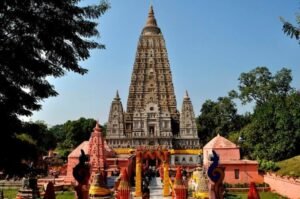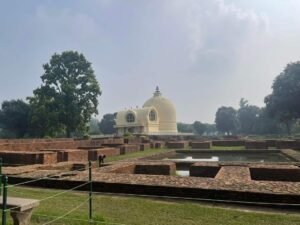The Eight Sacred Places Gautama Buddha Visited and Their Profound Significance
Gautama Buddha, the enlightened founder of Buddhism, left an indelible mark on the world through his teachings and the places he visited. These sacred sites, known as the Astamahasthanas (Eight Great Places), are tied to pivotal moments in his life and remain cherished pilgrimage destinations for Buddhists worldwide. Whether you’re a spiritual seeker, history enthusiast, or curious traveler, exploring these locations offers a deep connection to Buddha’s journey and the essence of his teachings. In this blog, we’ll uncover the eight key places Gautama Buddha visited, their spiritual importance, and why they continue to inspire millions. Let’s dive into this enlightening journey!
Why Are These Places So Important?
The eight sacred sites are not just historical landmarks—they’re spiritual beacons that encapsulate the core of Buddhism. Each location is linked to a significant event in Buddha’s life, from his birth to his enlightenment and final passing. Known as the Eight Great Events, these moments shaped Buddhist philosophy, emphasizing liberation, compassion, and mindfulness. Visiting these sites, often called the Buddhist Circuit, offers pilgrims and travelers a chance to reflect on the Four Noble Truths and the Eightfold Path while immersing in ancient history and serene landscapes.
Here’s a closer look at the eight sacred places Gautama Buddha visited and why they matter.
1. Lumbini, Nepal: The Birthplace of Buddha
Nestled in the lush plains of Nepal, Lumbini is where Queen Maya Devi gave birth to Prince Siddhartha (later Gautama Buddha) around 563 BCE under a sal tree. This UNESCO World Heritage Site is the starting point of Buddha’s extraordinary journey.
- Why It’s Important: Lumbini symbolizes the beginning of the path to enlightenment. The Maya Devi Temple, an Ashokan Pillar, and serene gardens mark this sacred spot, drawing pilgrims seeking to honor Buddha’s birth.
- Travel Tip: Located 10 hours by road from Kathmandu, Lumbini is accessible via Bhairahawa Airport (30-minute drive). Plan a visit to the monasteries built by global Buddhist communities for a multicultural experience.
SEO Keywords: Lumbini Nepal, Buddha’s birthplace, Buddhist pilgrimage sites
2. Bodh Gaya, India: Where Enlightenment Was Attained
In Bodh Gaya, Bihar, Siddhartha became the Buddha after meditating for 49 days under the Bodhi Tree around 528 BCE. This is the holiest site in Buddhism, where he achieved enlightenment and discovered the path to liberation.
- Why It’s Important: Bodh Gaya represents the pinnacle of spiritual awakening. The Mahabodhi Temple, a UNESCO World Heritage Site, houses a descendant of the original Bodhi Tree, making it a global hub for meditation and reflection.
- Travel Tip: Visit the vibrant monasteries and join meditation sessions to soak in the serene atmosphere. Bodh Gaya is easily accessible from Gaya Airport or Patna.
SEO Keywords: Bodh Gaya, Mahabodhi Temple, Buddha enlightenment
3. Sarnath, India: The First Sermon
Just outside Varanasi in Uttar Pradesh, Sarnath is where Buddha delivered his first sermon, the Dhammachakraparivartan Sutra, to five disciples. This event introduced the Four Noble Truths and the Eightfold Path, laying the foundation for Buddhism.
- Why It’s Important: Sarnath marks the birth of the Buddhist Sangha (monastic community). The Dhamek Stupa and the Ashoka Pillar’s Lion Capital (India’s national emblem) are iconic landmarks here.
- Travel Tip: Explore the Sarnath Museum for ancient Buddhist artifacts and visit nearby stupas for a glimpse into early Buddhist art.
SEO Keywords: Sarnath India, Buddha’s first sermon, Buddhist Circuit
4. Kushinagar, India: The Final Resting Place
In Kushinagar, Uttar Pradesh, Buddha attained Mahaparinirvana (passed away) at age 80 around 483 BCE, achieving final liberation from the cycle of birth and death. This serene site is a poignant reminder of impermanence.
- Why It’s Important: Kushinagar underscores the Buddhist teaching of detachment and liberation. The Parinirvana Temple, with its 6.1-meter reclining Buddha statue, and the Ramabhar Stupa (cremation site) are deeply moving.
- Travel Tip: Located 50 km from Gorakhpur, Kushinagar is ideal for quiet reflection. Combine your visit with nearby Buddhist sites for a fulfilling pilgrimage.
SEO Keywords: Kushinagar, Mahaparinirvana, Buddhist pilgrimage India
5. Sravasti, India: The Land of Miracles
Sravasti, in Uttar Pradesh, was where Buddha spent 24 rainy seasons at Jetavana Monastery, teaching and performing miracles, including creating multiple images of himself to inspire faith.
- Why It’s Important: Sravasti was a major center of Buddha’s teachings and miracles, reinforcing his spiritual authority. The Jetavana Monastery and Anathapindika Stupa are key attractions.
- Travel Tip: Sravasti is also sacred to Jains, making it a unique interfaith destination. Plan a day trip from Lucknow for a historical adventure.
SEO Keywords: Sravasti India, Jetavana Monastery, Buddha miracles
6. Rajgir, India: The Hub of Sermons
The ancient city of Rajgir in Bihar was a favorite of Buddha, where he delivered key sermons like the Lotus Sutra on Gridhakuta Hill. The first Buddhist council was held here after his passing.
- Why It’s Important: Rajgir was a vibrant center of Buddhist thought, with sites like Venuvana (Bamboo Grove) and the Shanti Stupa reflecting its spiritual legacy.
- Travel Tip: Trek to Gridhakuta Hill for panoramic views and a meditative experience. Rajgir is also a Jain pilgrimage site, adding to its cultural richness.
SEO Keywords: Rajgir Bihar, Gridhakuta Hill, Buddhist sermons
7. Sankassa, India: Descent from Heaven
In Sankassa, Uttar Pradesh, Buddha is believed to have descended from Tavatimsa Heaven after teaching his mother the Abhidhamma, accompanied by gods Indra and Brahma.
- Why It’s Important: This miraculous event highlights Buddha’s compassion and transcendence. Though less prominent today, Sankassa was a major pilgrimage site in ancient times.
- Travel Tip: Sankassa is quieter than other sites, perfect for those seeking solitude. Visit nearby Farrukhabad for additional historical exploration.
SEO Keywords: Sankassa India, Buddha’s descent, Buddhist sacred sites
8. Vaishali, India: The Final Sermon
Vaishali, Bihar, is where Buddha delivered his last sermon, announced his impending passing, and established the Bhikshuni Sangha (order of nuns). A monkey’s offering of honey here is one of the Eight Great Events.
- Why It’s Important: Vaishali symbolizes compassion and inclusivity in Buddhism. The Ashoka Pillar and relic stupa are must-see landmarks.
- Travel Tip: Vaishali’s historical significance as an early republic adds depth to your visit. Combine it with a trip to nearby Patna for a complete experience.
SEO Keywords: Vaishali Bihar, Buddha’s last sermon, Bhikshuni Sangha
Beyond the Eight: Other Places Buddha Visited
While the eight Astamahasthanas are the core pilgrimage sites, Buddha’s 45-year teaching journey took him to over 30–40 locations across northern India and Nepal. Notable mentions include:
- Nalanda, Bihar: Home to the ancient Nalanda University, where Buddha taught.
- Kapilavastu, India/Nepal: Buddha’s childhood home as Prince Siddhartha.
- Amaravati, Andhra Pradesh: A significant Buddhist center with a grand stupa.
These sites, though less emphasized, played a role in spreading Buddha’s teachings and shaping early Buddhism.
Why Visit the Buddhist Circuit?
The Buddhist Circuit is more than a travel itinerary—it’s a transformative journey. Here’s why these places resonate:
- Spiritual Growth: Each site offers a chance to meditate and connect with Buddha’s teachings on mindfulness and compassion.
- Historical Richness: UNESCO sites like Bodh Gaya and Lumbini preserve ancient art, stupas, and relics, offering a window into India’s past.
- Cultural Unity: Pilgrims from across the globe converge here, fostering a sense of shared humanity.
- Natural Beauty: From Lumbini’s gardens to Rajgir’s hills, these sites blend spirituality with serene landscapes.
Planning Your Pilgrimage
Ready to explore these sacred sites? Here are some tips:
- Best Time to Visit: October to March offers pleasant weather for travel across India and Nepal.
- How to Get There: Major sites like Bodh Gaya and Sarnath are well-connected by air (via Patna or Varanasi) and rail. Lumbini is accessible via Bhairahawa Airport.





